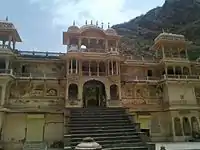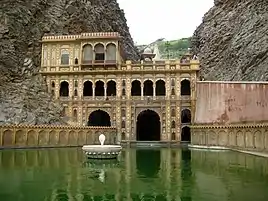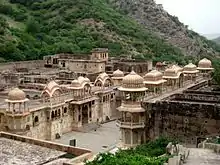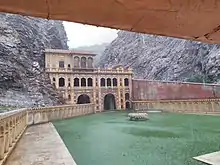Galtaji
Galtaji is an ancient Hindu pilgrimage about 10 km away from Jaipur, in the Indian state of Rajasthan. The site consists of a series of temples built into a narrow crevice in the ring of hills that surrounds Jaipur. A natural spring emerges high on the hill and flows downward, filling a series of sacred kunds (water tanks) in which pilgrims bathe. Visitors and pilgrims can ascend the crevasse, continuing past the highest water pool to a hilltop temple from there are views of Jaipur and its fortifications spreads out across the valley floor. It is believed that a Saint named Galav lived here, practiced meditation, and did penance (tapasya).[1]


Shri Galta Peeth ( Shri Galta Ji or Galav Ashram)
(A Registered Sole Trust Established in 1503 A.D.)

Built within a mountain pass in the Aravalli Hills 10 km. east of Jaipur,[2] Since the early 15th century Galtaji has been a retreat for Hindu ascetics belonging to the Vaishnava Ramanuja sect.[1] It is said to have been in the occupation of yogis for a long time; Payohari Krishnadas, a Ramanandi sadhu, i.e. a follower of the Ramanandi Sampradaya) came to Galta in the early 15th century and, by his yogic powers, drove away other yogis from the place.[3] Galta was northern India's first Vaishnava Ramanuja Peeth and became the one of the most important centres of the Ramanuja sect. The temple features a number of pavilions with rounded roofs, carved pillars and painted walls. The complex is set around a natural spring and waterfalls that create 7 Holy Ponds.[4]
Introduction About Galta Ji
This world-famous Pilgrims Paradise, popularly known as Shri Galtaji, is a Holy Ashram and a Governing Office of the Supreme of Shri Vaishnava Tradition which is also mentioned in many holy texts and scripts of the world.
Besides, the devotee masses of Jaipur and Rajasthan, the holiness of the place is being kept intact by the erstwhile rulers and the emperors as well as the representatives of the present Government of Independent India, including presidents, vice-presidents, governors, chief-ministers and other ministers as well as religious supreme and heads of different sects, philanthropists, politicians and government administrative heads and officials who also came to pay their homage.
This holy pilgrimage centre is a traditionally established Acharya Peetham (Holy Throne of the Supreme of a Religious Sect) in India consisting of a group of historical temples which is being elevated keeping its holiness intact by virtue of the penance, sacrifice and contribution by the traditional Acharyas of Shri Galtaji.
Under the holy guidance and direction of the Seventeenth and the present Office Bearer Jagadguru Shri Swami Sampatkumar Avadheshacharya Ji Maharaj of Shri Galta Peetham, the process of development of place with advanced facilities and arrangements is carried forward following the line laid down by the former Acharyas of the Peetham.
Besides its religious fans and the carriers of the Indian ancient religious tradition and culture, Shri Galtaji is appreciated by tourists, lovers of art and beauty and also the filmmakers throughout the world.
History About Galta Ji
This 'Galva Ashram' is named after the famous Holy Saint Galva, who performed penance for about 60,000 years in Satya Yuga and, according to the ancient beliefs, brought the sacred Gangaji to Shri Galtaji, which comes out of the Gau-mukh (Cow's mouth).
According to 'Galvashram Mahatmaya' on every full moon day of the Hindi month 'Karthik', Brahmaa, Vishnu and Shiva, the Trinity of Gods of Sanatan Dharma visit this holy place as the reason of which taking bath in the holy ponds provide divine blessings of God into multiple of trillions. Also the holy pilgrimage to all the four Dhams and the Saptpuris is considered to be incomplete unless the pilgrim does not come to take the holy bath in the pond of Galava Ashram.
This famous Galva Ashram is made popular in the name of Galta Gaddi (Peetham) by the founder Acharya the Miraculous Holy Saint Payohari Swami Shri Krishnadas Ji Maharaj in 1503 A.D. (Samvat 1560), who was named Payohari as he lived on the Cow-milk throughout.
He is also well known to spread the principles and teachings of Shri Vaishnava (Vishishtadwait) Philosophy of Ramanujacharya in North India as he influenced the then rulers of different erstwhile states with his unique and impossible miracles of spiritual powers for the betterment of the mankind. Out of his 12 main disciples, 2 of them Shri Kilhaji and Shri Aggra Ji are well-known. As the Bhishma of Mahabharta, Shri Kilha Devachrya Ji defined span of his lifetime who was placed on the holy Gaddi of Shri Galtaji as the second Acharya. Also, the then world famous Mughal Emperor Akbar came to Shri Galtaji to get his blessings. Afterwards, when his wishes were fulfilled he offered 2592 Bighas of land to the Acharya by one patta which is a historical document.
The famous 'Shri Nabhadas Ji', disciple of Shri Aggradas Ji lived and wrote his popular book 'Bhaktmaal' at Shri Galtaji, which is a religious text of Hindus. After seeing his supreme devotion in God, the all-time world-famous Saint Goswami Shri Tulsidas Ji stayed in Shri Galtaji for about 3 years where during his stay he wrote 'Ayodhya Kaand' of his well-known holy text Shri Ramcharitmanas.
It will be appropriate to mention here that philosophy of the recently established but famous 'ISKCON' by Swami Prabhupada used 'Govind Bhashya' as its philosophy written by Swami Shri Baldeo Vidhyabhushan, approximately 225 years ago at Shri Galta Ji. The first seven Acharya of the peetham were celibates. After which on the request of the founder of Jaipur and the then ruler of Jaipur State, Maharaja Sawai Jai Singh-II, the eighth Acharya Swami Shri Hariyacharya got married as it was being advised that, "unless the guru does not sit with his wife, the Ashwamegha Yagna will be unsuccessful which was going to be performed by the Ruler". Since then, it became a custom and all the later 10 Acharyas uptill today are married.
The names of the lineal Acharyas of Shri Galta Gaddi are :-
1. Payohari Swami Shri Krishnadas Ji Maharaj
2. Swami Shri Kilhadevacharya Ji Maharaj
3. Shri Krishnadevacharya Ji 'Videhi'
4. Shri Vishnudevacharya Ji
5. Shri Narayandevacharya Ji
6. Shri Haridevacharya Ji
7. Shri Ramprapannacharya (Madhuracharya) Ji
8. Shri Hariyacharya Ji
9. Shri Shriyacharya Ji
10. Shri Jankisharanacharya Ji
11. Shri Ramaacharya Ji
12. Shri Sitaramacharya
13. Shri Hariprasadacharya Ji
14. Shri Harivallabhacharya Ji
15. Shri Harisharanacharya (Shri Omkar Lal) Ji
16. Shri Ramodaracharya Ji
17. Shri Sampatkumaracharya
(Avadheshacharya) Ji (Present)
As Shri Galtaji being firstly established and Chief Jagadguru Peetham in Northern India, it was named and is known as Uttar-Totadri of Shri Vaishnavite Tradition.
For any such contribution which enriches the place, in the form of mental, physical and financial donation(s), please contact the office at Shri Galta Ji (the only office) and donors are requested to collect the receipt of their donation(s) made in cash and/or in kind.
Monkeys

The temple complex of Sita Ram ji temple is colloquially known as the Monkey temple (Galwar Bagh) in travel literature, due to the large number of monkeys who live in here. These rhesus macaques were featured in National Geographic Channel's Rebel Monkeys series and "Thar Desert - Sacred sand" episode of the Wildest India television series.
The Sun Temple
There is a small temple on the top of the hill dedicated to the Sun God. It is known as Surya Mandir.[6]
Water tanks
The temple is known for its natural springs, the water from which accumulates in tanks (kunds). There are seven tanks, the holiest being the Galta Kund, which never goes dry. It is considered auspicious to bathe in the waters of Galtaji, especially on Makar Sankranti, and thousands come to bathe every year.[7]

References
- Vibhuti Sachdev; Giles Henry Rupert Tillotson (2002). Building Jaipur: The Making of an Indian City. Reaktion Books. pp. 39–. ISBN 978-1-86189-137-2. Retrieved 29 August 2013.
- Dr. Daljeet; P. C. Jain (Prof.) (2002). Monuments Of India. Aravali Books International Pvt. Limited. p. 161. ISBN 978-81-86880-76-0.
- Gupta, Dr R.K; Bakshi, Dr S.R. Rajsthan through the ages - Vol 4. Jaipur rulers and administrators. Sarup & sons. p. 118. ISBN 978-81-7625-841-8.
- Ann Grodzins Gold (1990). Fruitful Journeys: The Ways of Rajasthani Pilgrims. University of California Press. pp. 278–. ISBN 978-0-520-06959-6. Retrieved 29 August 2013.
- Dobson, Jim. "48 Hours In Jaipur, India: How To Experience The Spectacular Pink City In Style". Forbes. Retrieved 18 December 2019.
- "Jaipur Tourism: Places to Visit, Sightseeing, Trip to Jaipur- Rajasthan Tourism". www.tourism.rajasthan.gov.in. Retrieved 18 December 2019.
- Dobson, Jim. "48 Hours In Jaipur, India: How To Experience The Spectacular Pink City In Style". Forbes. Retrieved 18 December 2019.
External links
![]() Media related to Galtaji at Wikimedia Commons
Media related to Galtaji at Wikimedia Commons